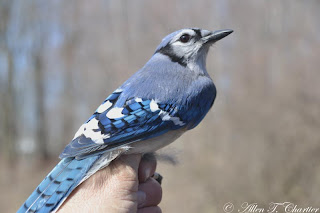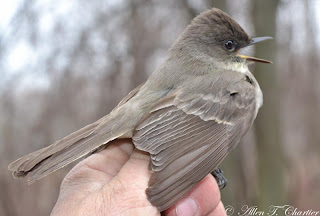Thank you to the following volunteers for making banding possible on these two days: John Bieganowski, David Boon, Scott Nottmeier, Tom Schlack, Edie Schmitz, and Blanche Wicke.
Highlights of the 77 birds banded on Wednesday, April 17 included the first Blue Jay of the spring. Variable numbers are captured each year, and their peak of migration is still a couple weeks away. But they are always beautiful to see up close.
 |
| After hatch-year Blue Jay |
Tree Swallows arrived in the banding area about ten days ago, but numbers still haven't really built up to the point where I was expecting to catch any. So the two today were a little earlier than normal.
 |
| After hatch-year male Tree Swallow |
There were good numbers of both kinglets in the banding area today. The number of Golden-crowneds is decreasing as they are past their peak of migration, while Ruby-crowns have not yet peaked. The four banded today were the first banded this spring.
 |
| After hatch-year male Ruby-crowned Kinglet |
 |
| After hatch-year male Ruby-crowned Kinglet |
Hermit Thrushes have been in the banding area for more than a week, but the first ones (12 actually) were captured today.
 |
| Second-year Hermit Thrush |
The first Yellow-rumped Warbler banded this spring was, likewise, not the first of its species observed this season, but tied the record for the earliest banded at this site.
 |
| Second-year male Yellow-rumped Warbler |
 |
| Second-year male Yellow-rumped Warbler |
Before today, only a couple Swamp Sparrows had been detected in the banding area, so the 9 banded today for the first time this season represented a real influx of migrants. There will be many, many more of these banded as the spring progresses.
 |
| After hatch-year Swamp Sparrow |
 |
| After hatch-year Swamp Sparrow |
Interesting birds observed, but not banded today included a flock of seven American White Pelicans circling over the beach, visible from the banding area, and were the first of this species ever recorded in the park. Four Common Loons flew over, and a Broad-winged Hawk was seen by David. American Kestrels were in view most of the day, with two seen together at one point so there was possibly some migration going on. Single Eastern Towhees and Chipping Sparrows were in the banding area, and two species not rare generally but rarely seen within the boundaries of the park included three flyover Rock Pigeons and a flyover Eastern Bluebird.
Highlights of the 62 birds banded on Saturday, April 20 included the first House Wren of the season. It was not observed, nor heard singing before it was captured, probably due to temperatures being in the upper 30s for most of the day. It was the earliest ever banded at this station, by one day.
 |
| After hatch-year House Wren |
After seeing and hearing the species in the banding area for the last week or so, finally one found its way into the nets.
 |
| Second-year male Eastern Towhee |
Eye color can be useful in ageing this species, while the black upperparts clearly indicates a male (brown in female). Eyes are brown in juveniles, and sometimes they will have brown eyes into their first spring so that they can be aged as second-year. But this bird had red eyes, yet I've aged it as second-year anyway.
 |
| Second-year male Eastern Towhee |
The primary coverts on this bird were dull and worn, contrasting with the secondary coverts, which is the basis for me calling this bird a second-year.
 |
| Second-year male Eastern Towhee |
The marsh/swamp transition habitat of the banding area is not a great place to find Savannah Sparrows, so the one banded today was only the 6th one ever banded here.
 |
| After hatch-year Savannah Sparrow |
 |
| After hatch-year Savannah Sparrow |
Last week, the few White-throated Sparrows banded were worn-looking, and clearly undergoing body molt. Today, there was a definite influx of the species, and all were in fine, fresh plumage, so they likely represent some of the first true migrants of the species in the banding area.
 |
| Second-year White-throated Sparrow |
Interesting birds observed, but not banded today included two Virginia Rails calling despite the chilly conditions, a flyover Belted Kingfisher, a singing Brown Thrasher, and a single Rusty Blackbird.
============================
Banding Data
-------------------------------------
WEDNESDAY, April 17, 2013
Sunrise (E.S.T.): 5:48
Time Open (E.S.T.): 6:00
Time Closed (E.S.T.): 13:30
Hours Open: 7.50
No. of Nets: 4.75-13.75
Net Hours: 93.625
Temperature (F): 43-59
Cloud Cover: 70-20%
Wind: NE @ 7-10-3 mph
Barometer: 29.69-29.62
Precipitation: None
No. Banded: 77 (plus 14 recaptured and 1 released unbanded)
No. of Species: 18
Capture Rate: 98.3 birds per 100 net hours
Volunteers (worked 10.50 hours, 5:00-15:30): John Bieganowski, David Boon.
Downy Woodpecker - 2 (plus 1 recaptured)
Blue Jay - 1
Tree Swallow - 2
Black-capped Chickadee - 3 (plus 1 recaptured)
Brown Creeper - 6 (plus 1 recaptured)
Golden-crowned Kinglet - 6 (plus 1 recaptured)
Ruby-crowned Kinglet - 4
Hermit Thrush - 12
American Robin - 2 (plus 3 recaptured)
Yellow-rumped Warbler - 1
American Tree Sparrow - 3
Song Sparrow - 5 (plus 3 recaptured)
Swamp Sparrow - 9
White-throated Sparrow - 1
Northern Cardinal - 1 (plus 1 recaptured)
Red-winged Blackbird - 9 (plus 1 released unbanded)
Brown-headed Cowbird - 1
American Goldfinch - 9 (plus 3 recaptured)
-------------------------------------
SATURDAY, April 20, 2013
Sunrise (E.S.T.): 5:43
Time Open (E.S.T.): 6:15
Time Closed (E.S.T.): 13:45
Hours Open: 7.50
No. of Nets: 4.75-13.75
Net Hours: 98.313
Temperature (F): 34-43
Cloud Cover: 20-90%
Wind: WNW @ 7-10-5 mph
Barometer: 29.25-29.59
Precipitation: Trace of snow
No. Banded: 62 (plus 20 recaptured and 3 released unbanded)
No. of Species: 17
Capture Rate: 86.5 birds per 100 net hours
Volunteers (worked 10.5 hours, 5:00-15:30): Scott Nottmeier (5.0 hrs), Tom Schlack (5.5 hrs), Edie Schmitz, Blanche Wicke.
Downy Woodpecker - 1 (plus 1 recaptured)
Black-capped Chickadee - 1 (plus 2 recaptured and 1 released unbanded)
Brown Creeper - 5 (plus 1 recaptured)
House Wren - 1
Winter Wren - 1
Golden-crowned Kinglet - 1
Ruby-crowned Kinglet - 6
Hermit Thrush - 6 (plus 2 recaptured and 1 released unbanded)
American Robin - 5
Eastern Towhee - 1
American Tree Sparrow - 4
Savannah Sparrow - 1
Song Sparrow - 2 (plus 6 recaptured)
White-throated Sparrow - 9 (plus 1 released unbanded)
Northern Cardinal - 1 (plus 1 recaptured)
Red-winged Blackbird - 2 (plus 1 recaptured)
American Goldfinch - 15 (plus 6 recaptured)

















